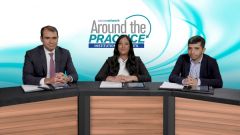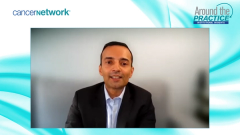
Patient Case 2: Managing Heavily Pre-Treated MM With Talquetamab
Switching focus to GPRC5-targeted bispecific antibody therapy, expert hematologist-oncologists review a patient case of relapsed/refractory MM managed with talquetamab.
Episodes in this series

Transcript:
Ajai Chari, MD, PhD: Now that we completed this robust discussion about BCMA, there is live factor BCMA. And aside from BCMA, so let's hear about some other targets. Sham, you have a case for us.
Sham Mailankody, MD: This is a 63-year-old female. Her labs had an m spike of 1.59 mild anemia, a bone marrow biopsy. Then about 10 years back, which is when she was diagnosed showing 50% myeloma cells. She has ISS [International Staging System] stage one myeloma, durie-salmon stage one, there was no fissure cytogenetics done at the time. And this is her treatment history, standard, a couple of trials there as you can see started with RVD induction followed by high dose melphalan in stem cell support, lenalidomide maintenance, which was for about 3 years, at which point she progressed. And then, went on a clinical trial of PD-L1 antibody with lenalidomide. And after 5 cycles, progressed as well. And then, subsequently, elo-based therapy and dara-based therapy. And the most recent line is dara ixazomib dex on which she progressed. At this point, which was now 5 lines in, as 6 line treatment, she was on a trial of talquetamab, which is a GPRC5D targeted bispecific antibody. And she started this in 2018. And again, we'll go through this more, but she had CRS grade I during the first cycle. Some cytopenias mostly during the first couple of cycles. She did have some change in taste which again we'll go through, in the discussions for about 2 to 3 days transient, no weight loss and grade I nail changes as well which add eventually result. This is her free light-chain assessments. She had a high free light-chain at screening. And then, like the previous graphs if you recall after the first few cycles, quickly went down, and stayed very low. This is a patient who ultimately achieved MRD negative stringent complete response that's about 4 years now. I remember she went on this study in 2018, she's ongoing 4 years. And notably, she was on the phase 1 dose escalation study for talquetamab and one of the lower doses of this study, not even the right, what we now know, as recommended phase 2 dose for this drug. And then, this is just looking at Covid-19 antibody responses and this patient over time suggesting that even with talquetamab - even that being on talquetamab for 4 plus year, patients can respond to Covid-19, at least have antibody response to Covid-19 vaccination. And this comes back to the point that I was making that we should really be strongly encouraging patients to get appropriately vaccinated for Covid-19 and other preventable infections despite being on these immunosuppressive treatments both for antibody responses but also T-cell responses to those vaccines.
Ajai Chari, MD, PhD: Great, thank you. And I should just mention that there will be a confirmatory presentation at this year's ASH [American Society of Hematology meeting 2023]. I have the privilege to do on behalf of my colleagues from the MONUMENTAL-1, which is basically talquetamab. This is the expansion of the RV2D dosing. There are 2 different doses, one is every week and 0.4 mg/kg. The other one is every 2 weeks and 0.8. And basically, the take home message, again, is that 60 to 100 is again the new 20 to 30. Response rate is 70%, the PFS for the first cohort is around 7.6 months. And also, we'll be hearing interesting updates about prior T-cell radioactive therapies, which is, again, the new unmet need is in patients who've already had one T-cell redirection, what happens next? That data will be forthcoming. And the AE [adverse effect] profile is what we've heard from the part - the dose escalation part, which is CRS low grade, the dysgeusia, the nail and some weight loss. But these are typically low grade and the majority of patients are staying on treatment. With that, I'm curious what you all think about this targeted. I should emphasize one other unique thing about this, we do have some toxicities that are probably off tumor on target which is the skin dysgeusia. But the infection and your case, Sham, shows that those antibodies were recovering which we usually don't see with BCMA targeting therapies, right? Because you have that persistent hypogamma. This patient was getting a very homeopathic dose which, again, speaks to, what do we know about these constructs, right? What is the right dose and schedule and long term maintenance? But the fact that you're able to get sustained remission without a complete paresis of the immune system is interesting. And it's supported by typically grade III/IV infections remaining less around 10%, which is quite good for such heavily treated population in contrast to the BCMA bispecifics We're seeing upwards of 40% grade III/IV infections with longer follow up. It's a slightly different target and perhaps less COVID-19 related deaths even though also occurring in COVID-19. It's a unique agent. I'll throw it out to you guys. Where do you think GPRC5D belongs in this ever-increasing myeloma armamentarium that we're having?
Sham Mailankody, MD: The nice thing, as you said, it's a different target. We've spent so much time talking about BCMA, so many different BCMA therapies, having a different target is certainly good. We will, as you said, hear more at ASH, but already emerging data that certainly these drugs have non overlapping mechanisms such that you see good responses in patients with prior T-cell directed therapies with a GPRC5D targeted treatments. That's the obvious excitement is that that this is now - although it's a bispecific, probably that presents a new class or sub class of drugs for our patients. And therefore, we're excited to be able to use drugs targeting or treatments targeting GPRC5D more widely for our patients. In terms of, I guess, if you were asking about sequencing of GPRC5D before or after BCMA, some of that will be, I think, logistic and organic. There's already studies of BMCA directed therapies going on in earlier lines. Depending on those results, we might start using BCMA therapies earlier. Whereas GPRC5D is still being doubled up in the relapse refractory setting. The sequence in how these treatments are being doubled up might inform how we use them in 2 to 3 years. Hopefully, we'll also learn more about the biology of these different drugs, toxicity management subset, we can also make an informed decision of what's the right sequence of using these targets for our patients.
Transcript edited for clarity.
Newsletter
Stay up to date on recent advances in the multidisciplinary approach to cancer.






















































































